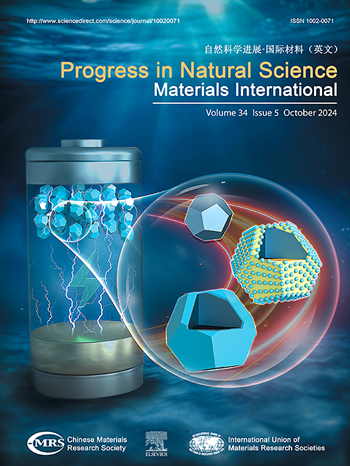具有多级片状微结构的 TC18 钛合金的应力-应变兼容性和断裂行为研究
IF 7.1
2区 材料科学
Q2 MATERIALS SCIENCE, MULTIDISCIPLINARY
Progress in Natural Science: Materials International
Pub Date : 2024-10-01
DOI:10.1016/j.pnsc.2024.07.020
引用次数: 0
摘要
了解断裂机制对于优化钛合金的机械性能至关重要。通过原位拉伸和三点弯曲试验,研究了 TC18(Ti-5Al-5Mo-5V-1Cr-1Fe)合金的断裂行为与多级片状微结构之间的关系。结果表明,TC18 合金具有多级层状微结构(包括 β 基体、初级层状 α 相、束和次级层状 α 相),在强度和延展性方面表现出优异的组合。次生层状 α 相的析出大大提高了合金的强度,但却削弱了微结构的应力-应变相容性。这导致裂纹尖端塑性区(CTPZ)变小,并使位错更多地集中在晶界,其次是相界面。因此,在裂纹扩展的后期阶段,微空洞和微裂纹往往会在位错堆积处形成。随着应力的增加,这些微空洞和微裂纹会迅速凝聚,导致更大比例的晶间断裂,从而降低合金的断裂韧性。本文章由计算机程序翻译,如有差异,请以英文原文为准。
Investigation into the stress‒strain compatibility and fracture behaviour of a TC18 titanium alloy with a multistage lamellar microstructure
Understanding the fracture mechanism is essential for optimizing the mechanical properties of titanium alloys. The relationship between fracture behaviour and the multistage lamellar microstructure of the TC18 (Ti–5Al–5Mo–5V–1Cr–1Fe) alloy was investigated via in situ tensile and three-point bending tests. The results indicate that the TC18 alloy, featuring a multistage lamellar microstructure (including a β matrix, primary lamellar α phase, bundles, and secondary lamellar α phase), exhibits an excellent combination of strength and ductility. The precipitation of the secondary lamellar α phase significantly enhances the alloy's strength but weakens the stress‒strain compatibility of the microstructure. This results in a smaller crack-tip plastic zone (CTPZ) and causes dislocations to concentrate more at the grain boundaries and, to a lesser extent, at the phase interfaces. Consequently, in the later stages of crack propagation, microvoids and microcracks tend to form at dislocation pile-ups. With increasing stress, these microvoids and microcracks rapidly coalesce, leading to a greater proportion of intergranular fracture and thus reducing the fracture toughness of the alloy.
求助全文
通过发布文献求助,成功后即可免费获取论文全文。
去求助
来源期刊
CiteScore
8.60
自引率
2.10%
发文量
2812
审稿时长
49 days
期刊介绍:
Progress in Natural Science: Materials International provides scientists and engineers throughout the world with a central vehicle for the exchange and dissemination of basic theoretical studies and applied research of advanced materials. The emphasis is placed on original research, both analytical and experimental, which is of permanent interest to engineers and scientists, covering all aspects of new materials and technologies, such as, energy and environmental materials; advanced structural materials; advanced transportation materials, functional and electronic materials; nano-scale and amorphous materials; health and biological materials; materials modeling and simulation; materials characterization; and so on. The latest research achievements and innovative papers in basic theoretical studies and applied research of material science will be carefully selected and promptly reported. Thus, the aim of this Journal is to serve the global materials science and technology community with the latest research findings.
As a service to readers, an international bibliography of recent publications in advanced materials is published bimonthly.

 求助内容:
求助内容: 应助结果提醒方式:
应助结果提醒方式:


